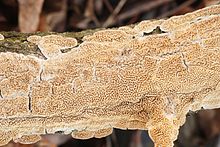
Irpex lacteus

Irpex lacteus is a common crust fungus distributed throughout temperate areas of the world. It is the type of the genus Irpex. Irpex lacteus is considered a polypore, but depending on growth conditions it can also produce a hydnoid hymenophore. Due to this variability and abundance of the species it has been described as a new species to science numerous times and subsequently has an extensive synonymy. The complete genome sequence of Irpex lacteus was reported in 2017. Irpex lacteus is a white-rot fungus that inhabits mainly angiosperm branches and trunks. It is one of the most common wood-rotting fungi for instance in urban North America. The fungus was first described in 1818 by Elias Magnus Fries, who called it Sistotrema lacteum. Fries later made it the type species of the genus Irpex in 1828.
